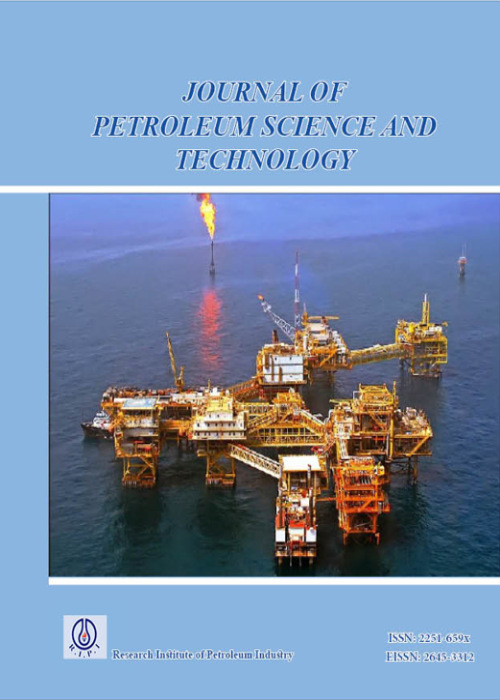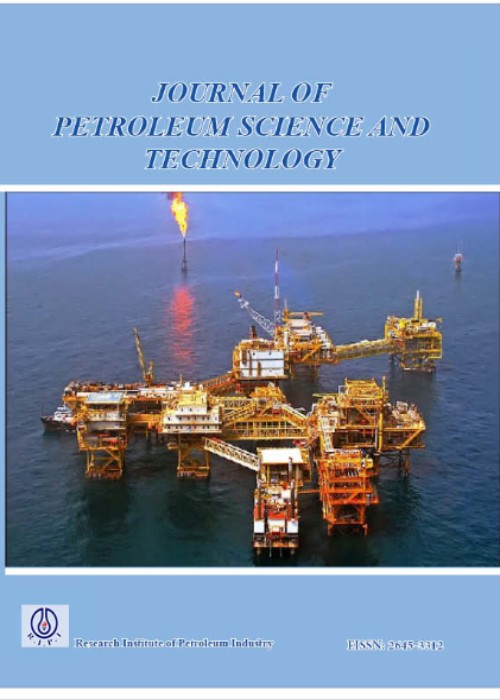فهرست مطالب

Journal of Petroleum Science and Technology
Volume:12 Issue: 3, Summer 2022
- تاریخ انتشار: 1402/04/13
- تعداد عناوین: 6
-
-
Pages 2-11As carbon dioxide emissions rise worldwide, the world is still experiencing many consequences of these emissions. This challenge can be addressed using carbon capture, utilization, and storage (CCUS). Energy transfer generally requires a good program in which CCUS plays a crucial role. CO2-EOR, which allows for storing carbon dioxide (CO2), is a suitable option in this area. It provides economic returns from oil that could not be recovered before without this method and has environmental benefits, which shows its importance compared to other EOR methods. In this study, an oil reservoir is simulated using field data to compare this method with the water injection method and natural depletion method of the reservoir. Water and CO2 injection increased oil recovery by 8.4% and 12.7%, compared to natural depletion. The surrogate reservoir model was built using the machine learning (ML) technique by choosing the scenario of CO2 injection to reduce the computational load and the possibility of using it in optimization tasks. Therefore, using the data-driven model, we can reproduce the data related to the CO2-EOR process in a much shorter period of time, thereby allowing us to select the most efficient parameters and their ranges for different processes. The numerical simulator was run 250 times to extract the necessary data. The ANN is applied to the data and trained after the database is built and the hyper-parameters have been optimized. ANN consists of two hidden layers with 81 and 51 neurons, respectively, and a 0.05 learning rate after optimization. The trained two-objective ANN was a MAPE of less than 2.5% in the test data for both objectives, i.e., oil recovery and carbon dioxide storage. To further validate and ensure the accuracy of the trained ANN, the numerical simulator was run randomly ten times and compared with the values predicted by the ANN. MAPE for both objectives was less than 2.6%. Therefore, the ANN that makes predictions in a fraction of a second has a suitable accuracy that can be used as a surrogate reservoir model.Keywords: Enhanced Oil Recovery, CO2-EOR, Simulation, Oil Reservoirs, Artificial Neural Networks (ANNs), Water Injection
-
Pages 12-17Static Young’s Modulus is a measure of reservoir rock stiffness and is best determined by experimental studies on cores. However, the experimental procedures are demanding with considerable cost. On the other hand, a dynamic Young’s modulus can easily be estimated from readily available petrophysical data. The static young’s modulus can easily be obtained from the dynamic counterpart by empirical relationships. This research attempts to use AI techniques to predict Static Young’s modulus. Two thousand three hundred fifty data sets were collected from several wells in the Middle East with sandstone and limestone lithology and used to build an AI model. Each data set contains static Young’s Modulus as a function of the bulk density, shear wave arrival time, and compressional wave arrival time. An artificial neural network (ANN) model was developed to predict the static young’s modulus with high accuracy of R2 = 0.999 and AARE of 0.028%. The proposed model was validated with measured reservoir rock data and was compared with four different correlations. The results showed that the model provided the highest coefficient of determination (R2) and the lowest standard deviation.Keywords: Young’s Modulus, neural network, bulk density, shear wave arrival time, compressional wave arrival time
-
Pages 18-23Fracture network modeling is important in simulating fluid flow, identifying reservoir storage areas, recognizing aquifers, and managing the groundwater pathway to prevent wall failure in mine stability consideration. In other words, precise estimation of mass transport and hydrology parameters depends on the accuracy of fracture modeling. This study presents a new iterative fracture network-modeling MATLAB code that directly models the statistical geometry of the fractures. The code is employed to simulate the parameters of fractures in terms of density, orientation, and length distribution. The method is applied to a real 2-Dimensional fracture network image from an exposed wall to demonstrate the effectiveness of the presented code. Its performance is assessed by three criteria, including fracture length distribution, producing fracture orientation, and fracture density. According to the assessment results, the statistical method can reproduce the length distribution and density of the fracture network similar to the reference. In addition, the method performs almost well in modeling the orientation of fractures.Keywords: Fracture Network Modelling, Statistical Fracture Generator, MATLAB code, Fracture Length, Fracture Density, Fracture Distribution
-
Pages 24-36Asphaltene precipitation causes a decrease in the effective mobility of hydrocarbon through pore throats plugging and, as a result, the rock permeability. Moreover, by changing the reservoir rock wettability, asphaltene reduces the effective oil permeability and increases the amount of residual oil in porous media. Furthermore, change in the fluid viscosity should also be considered as a determining factor. This study aims to model asphaltene precipitation in the reservoir and evaluate this phenomenon’s consequences regarding the effects on the wells’ Productivity Index (PI). After developing a thermodynamic asphaltene model based on Cubic Peng-Robinson EOS, the fluid model was exported into a commercial compositional simulator using in-house PVT software. Besides, asphaltene behavior was described using the solid model. Then, the dynamics of the precipitated asphaltene were investigated using deposition, porosity reduction, permeability reduction, and viscosity change models in the mentioned simulator. Additionally, a sensitivity analysis was done to see how deposition model parameters and the production rate can probably affect the formation damage and final Wells’ PI under natural reservoir depletion. Finally, the most significant parameters triggering asphaltene damage were identified. The results indicated that the damage triggered by asphaltene deposition, through plugging and decreasing porosity and permeability, and a change in viscosity was disclosed as a decline in wells’ PI. The results also showed that although adsorption significantly affects the decrease in wells’ PI, plugging is a more determining mechanism.Keywords: Thermodynamic model, deposition model, Compositional Simulator, Productivity Index
-
Pages 37-49
In the drilling industry, one of the most important parameters to improve the drilling of new wells is studying the previously-drilled wells to find major common problems and use new methods to prevent them. This article has aim to discover the root cause of loss circulation and its consequences problems right in one of the Middle East oil fields. Also, it will be discussing customizing solutions to cure or prevent such problems. Previous problems are interpreted based on lithology, hydraulic and rheological parameters. Loss circulation volume and rheological parameters (eg gel strength) were analyzed in 12 drilled wells in the specific field. Based on the results, in 5 wells, the loss problem was severe, and the cause was the creation of induced fractures due to the high volume of gel strength. Also, using the geo-mechanical models revealed that induced fracture was expected to develop approximately 36 microns through drilled formations. that the reducing gel strength is sometimes not affordable due to hole cleaning issues. Hence, it has been customized for loss prevention. Accordingly, the wellbore strengthening materials with a mean size of 36 microns were proposed to increase the fracture gradient of formations pressure to drill with high-density muds. By implementing recommended materials in two new wells with high-gel strength, fluid losses, and related problems were considerably showed a reduction. Thereafter, Nonproductive time compared with previously-drilled wells was reduced between 71 to 89%. Also, fluid loss volume dropped from 511 bbl to 75-100 bbl in each nominated well. Meaning an 80-85% reduction in fluid loss, indicating reasonable achievements.
Keywords: Mud Loss Circulation, Drilling Problems, Drilling Fluids, Induced Fracture, Loss Preventative Material -
Pages 50-55Determining and estimating reservoir properties such as capillary pressure and relative permeability are always challenging in reservoir studies. The current research has been done in the Sarvak Formation in the southwestern oilfields of Iran, focusing on applying Nuclear Magnetic Resonance (NMR) logging in synthesizing capillary pressure and relative permeability. In this study, the Sarvak Formation in the studied well was divided into three flow units using the Hydraulic Flow Unit method. Then, for each separate flow unit, the capillary pressure curves were calculated and illustrated from the NMR T2 distribution data. Next, the calculated capillary pressure curves were corrected concerning the laboratory capillary pressure data derived from SCAL. Then, the conversion factor to calibrate well log-derived Pc curves to SCAL Pcs was determined for each flow unit. Afterward, mathematical functions for capillary pressure curve estimation were written using MATLAB software. Next, the relative permeability for oil and water phases was calculated and plotted in MATLAB software based on the functions determined in the previous step. Finally, the representative capillary pressure curve and relative permeability curve of the oil and water phases were determined for each flow unit. The results showed an increasing trend in the reservoir quality from flow units 1 to 3. Flow unit 3 had the lowest capillary pressure with the highest relative permeability and, consequently, better reservoir quality. In contrast, flow unit 1 had the highest PC levels, the lowest relative permeability, and the lowest reservoir quality.Keywords: Nuclear Magnetic Resonance, NMR, Relative Permeability, Capillary Pressure, Sarvak Formation


